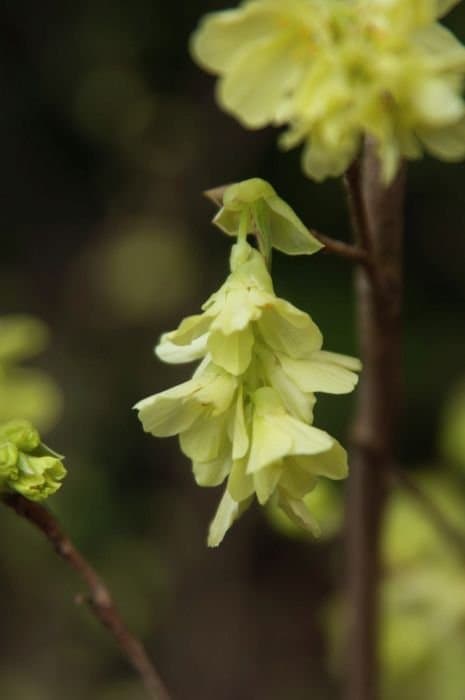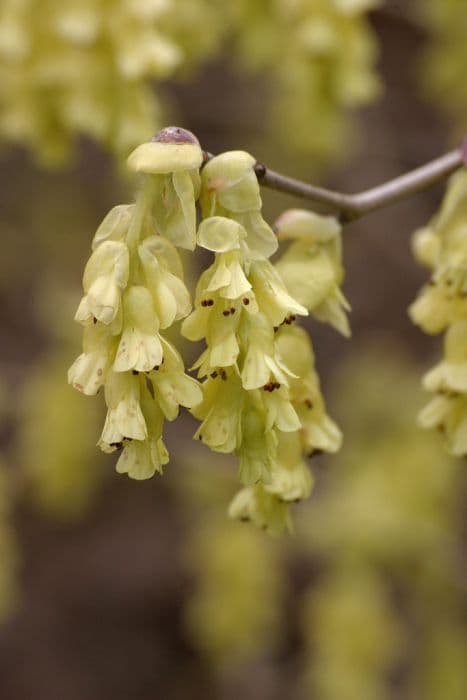Chinese witch hazel Hamamelis mollis

ABOUT
Hamamelis mollis, commonly known as Chinese witch hazel, is a deciduous shrub notable for its unique and attractive flowers. Its appearance is characterized by broadly oval, unevenly wavy leaves that bear a resemblance to hazelnut foliage, displaying a rich green color on top and a paler underside. The leaves often turn to vibrant shades of yellow in the fall, bringing a splash of autumn color to the landscape. The most striking feature of Chinese witch hazel is its fragrant, spider-like flowers. The flowers are relatively small and consist of narrow, ribbon-like petals that burst forth in clusters. These petals exhibit a bright yellow hue, and occasionally can have a reddish-purple base, creating a delightful contrast against the wintery backdrop when most other plants are dormant. The blossoms typically appear in the winter to early spring, providing an unusual and welcome sight during the colder months. Chinese witch hazel also has a smooth, gray bark that adds to its visual interest throughout the year, particularly after the leaves have fallen. The overall shape of the plant is somewhat vase-like, with a spreading, open habit that can contribute a striking architectural element to gardens or naturalized areas. The wood of Chinese witch hazel is also noteworthy for being quite hard and dense. Despite these diverse features, the size of Chinese witch hazel does not define its beauty and therefore is not discussed in its description. Overall, Chinese witch hazel is valued for its year-round appeal, from the lush greenery in the growing season to the exquisite blooms in the cold months and the golden fall foliage. It is a versatile plant that can serve as a focal point in a variety of garden settings.
About this plant
 Names
NamesFamily
Hamamelidaceae
Synonyms
Chinese Witch Hazel, Winter Bloom
Common names
Hamamelis japonica var. mollis, Hamamelis chinensis, Hamamelis cordata, Hamamelis mollis var. cordata.
 Toxicity
ToxicityTo humans
Witch hazel, which is the common name for Hamamelis mollis, is generally considered non-toxic to humans. There is no well-documented evidence of toxicity or poisoning from ingesting this plant. As with any plant material, individual allergies or sensitivities might occur, but these are typically not severe.
To pets
Witch hazel, the common name for Hamamelis mollis, is generally recognized as safe for pets. There is no significant toxicity reported in pets that ingest this plant. As with any non-food plant, ingestion in large amounts might cause mild gastrointestinal upset, but it is not known to be a common cause of poisoning in pets.
 Characteristics
CharacteristicsLife cycle
Perennials
Foliage type
Deciduous
Color of leaves
Green
Flower color
Yellow
Height
12 feet (3.66 meters)
Spread
12 feet (3.66 meters)
Plant type
Shrub
Hardiness zones
5
Native area
China
Benefits
 General Benefits
General Benefits- Ornamental Value: Hamamelis mollis, commonly known as Chinese witch hazel, is widely appreciated for its unique and fragrant yellow flowers that bloom in late winter to early spring, providing color and interest during the dull winter months.
- Attracts Wildlife: The flowers produce nectar and pollen that attract pollinators such as bees when few other food sources are available, supporting local ecosystems.
- Seasonal Interest: With its vibrant autumn foliage, Chinese witch hazel displays striking colors, such as yellow, orange, and red, adding aesthetic value to gardens during the fall season.
- Low Maintenance: Once established, Chinese witch hazel is relatively low maintenance, requiring minimal care other than occasional pruning to maintain its shape.
- Drought Tolerance: The plant is reasonably drought-tolerant, making it suitable for gardens in regions with less frequent rainfall.
- Shade Tolerance: It can grow in partial shade, making it versatile for planting in various locations within a garden or landscape.
- Tolerance of Different Soil Types: Chinese witch hazel is adaptable to a range of soil types, although it prefers well-drained, loamy soil.
- Privacy and Screening: With its dense growing habit, it can be used as a screening plant to provide privacy in residential gardens.
- Winter Interest: Its characteristic spider-like flowers and fragrance during winter months add sensory interest to gardens when most other plants are dormant.
 Medical Properties
Medical Properties- astringent: Witch hazel, which contains tannins, has historically been used for its astringent properties, meaning it can help to constrict skin tissue.
- anti-inflammatory: It has been used to soothe and reduce inflammation in various skin conditions.
- hemostatic: Witch hazel is known to have been used to slow down or stop bleeding.
- skin irritation relief: Traditionally, witch hazel has been applied to the skin to relieve minor irritations and itching.
 Air-purifying Qualities
Air-purifying QualitiesThis plant is not specifically known for air purifying qualities.
 Other Uses
Other Uses- Witch Hazel can be used in landscaping as a decorative plant, particularly for its fragrant winter flowers which add color to gardens during the typically bland winter months.
- The branches and twigs of Witch Hazel can be used in floral arrangements, providing both scent and a unique aesthetic with their spider-like flowers.
- Witch Hazel can be used as a natural fencing or screening plant because of its dense growth habit, offering privacy in residential gardens.
- The plant is sometimes incorporated into sensory gardens, where its textured leaves and fragrant flowers can be enjoyed by individuals with visual impairments.
- Witch Hazel can be planted to provide habitat and food for wildlife; its flowers are a winter food source for certain bird species.
- The leaves of Witch Hazel can be used to make a natural dye, which traditionally has been used for fabric coloring.
- Wood from the Witch Hazel can be used for small woodworking projects and crafting, like the making of walking sticks or carving.
- In folklore, twigs of Witch Hazel have been used as divining rods to locate underground water sources.
- Witch Hazel is sometimes used as a "nurse plant" in forestry, helping to protect more delicate trees as they grow.
- Artisans may incorporate Witch Hazel into wreaths and other dried flower arrangements due to its attractive fall foliage and unique seed capsules.
Interesting Facts
 Feng Shui
Feng ShuiWitch Hazel is not used in Feng Shui practice.
 Zodiac Sign Compitability
Zodiac Sign CompitabilityWitch Hazel is not used in astrology practice.
 Plant Symbolism
Plant Symbolism- Hope and New Beginnings: Hamamelis mollis, commonly known as Chinese witch hazel, flowers in late winter or early spring, often when much of nature seems asleep, symbolizing the hope and the promise of new beginnings.
- Healing and Protection: With its astringent properties and history in traditional medicine, Chinese witch hazel represents healing and protection against illnesses and adverse conditions.
- Fragility and Delicacy: The delicate yellow flowers of Chinese witch hazel symbolize fragility and the gentle touch required to nurture relationships and ventures.
- Uniqueness and Individuality: Blooming at a time when few other plants do, Chinese witch hazel stands for uniqueness and individuality, highlighting the beauty of standing out.
 Water
WaterThe common name for Hamamelis mollis is Witch Hazel, and it prefers to be watered when the top inch of soil begins to feel dry to the touch. It's best to water this plant thoroughly, allowing water to run through the drainage holes, and then wait for the soil to dry out before watering again. During the growing season in spring and summer, Witch Hazel may need watering once a week, but this can vary depending on climate and weather conditions. Generally, you can expect to use about 1-2 gallons of water every week or two, making sure to adjust during rainy periods or drought. Overwatering can lead to root rot, so it's important to ensure the soil is well-draining and not to leave the plant sitting in water.
 Light
LightWitch Hazel thrives in full sun to partial shade. The best spot for this plant would be where it can receive at least 4-6 hours of direct sunlight daily, with some afternoon shade in particularly hot climates to prevent leaf scorch. It tolerates various lighting conditions but will flower best with adequate sunlight.
 Temperature
TemperatureWitch Hazel performs well in a range of temperatures, and is hardy down to around -20°F and can tolerate summer temperatures up to 100°F. The ideal temperature conditions for Witch Hazel are between 60°F and 75°F during the growing season. It's a hardy plant that can withstand seasonal temperature fluctuations well.
 Pruning
PruningWitch Hazel should be pruned to maintain shape and remove any dead or damaged branches. The best time for pruning this plant is in early spring, after the flowers have faded but before new growth starts. Generally, pruning once a year is sufficient, but occasional removal of suckers or misplaced branches can be done anytime.
 Cleaning
CleaningAs needed
 Soil
SoilThe Chinese witch hazel (Hamamelis mollis) thrives in well-draining, loamy soil that is rich in organic matter. A suitable soil mix can be created by blending equal parts of loam, peat, and coarse sand or perlite to ensure good drainage. The ideal soil pH for Chinese witch hazel is slightly acidic to neutral, ranging from 6.0 to 7.5.
 Repotting
RepottingChinese witch hazel typically does not need to be repotted often. It can be repotted once it outgrows its current container, which may be every 3 to 5 years. When repotting, ensure the new pot is only slightly larger than the previous one to avoid oversizing.
 Humidity & Misting
Humidity & MistingChinese witch hazel prefers average household humidity levels. It can adapt to lower humidity but would appreciate a boost during dry winter months. There is no strict humidity level requirement but maintaining indoor humidity around 40-50% is beneficial.
 Suitable locations
Suitable locationsIndoor
Provide bright light, avoid dry heat, and mist regularly.
Outdoor
Place in full sun to partial shade in well-drained soil.
Hardiness zone
5-8 USDA
 Life cycle
Life cycleHamamelis mollis, commonly known as Chinese witch hazel, begins its life cycle when the seeds germinate in moist, well-drained soil in partial to full sun conditions. The seedling emerges and develops into a young plant, producing broad leaves that will collect sunlight for photosynthesis. As it matures, Chinese witch hazel forms a woody, multi-stemmed shrub, which can reach up to 15 feet tall and wide. It enters a stage of flowering typically in late winter to early spring before the leaves appear, producing fragrant yellow flowers with distinctive ribbon-like petals, capable of withstanding cold temperatures. These flowers are pollinated by insects, leading to the formation of seed capsules that ripen in fall and eject seeds several meters away from the parent plant. The plant then goes into dormancy during winter, shedding its leaves, and the cycle continues the following spring as new growth emerges.
 Propogation
PropogationPropogation time
Late winter
The common name for Hamamelis mollis is Chinese witch hazel, and one of the most popular methods of propagating this plant is through semi-hardwood cuttings. This is typically done in late summer to early fall, after the current year's growth has begun to mature and harden slightly. To take a cutting, select a healthy branch that is about the thickness of a pencil, and cut a 4 to 6 inch (10 to 15 centimeters) length from the tip. The base of the cutting should be made just below a leaf node, where the concentration of natural rooting hormones is higher. Remove the leaves from the lower half of the cutting to prevent moisture loss, and dip the cut end in a rooting hormone powder to encourage root development. Then, plant the cutting in a moist mixture of half peat and half perlite or sand, ensuring that several nodes are buried where leaves were removed. Place the cutting in a warm, bright area out of direct sunlight, and keep the soil consistently moist until roots develop and new growth is observed, indicating successful propagation.









